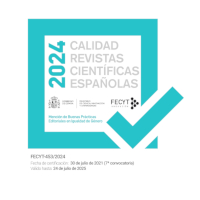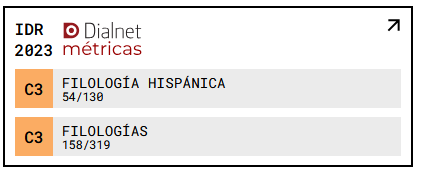Función antropológica del cronotopo en la trama de “Robinsones rusos”
DOI:
https://doi.org/10.18172/cif.5817Palabras clave:
Cronotopo, Función Antropológica del Cronotopo, Modelos de Comportamiento, Robinsones Rusos, Le Roux, Zinoviy DavydovResumen
El enfoque antropológico hacia la obra de arte es una corriente relevante en la crítica literaria. El ser humano es tanto sujeto como objeto de la antropología artística. Utilizando el concepto literario tradicional del cronotopo, este artículo intenta explicar el lugar del ser humano en la representación del mundo en una obra de arte. Se presta especial atención a la categoría del cronotopo, en particular, a su función antropológica. La función antropológica del cronotopo se analiza en la novela “Beruny” (1933) de Zinoviy Samoilovich Davydov. Al crear su obra original, el autor se inspiró en la historia favorita del lector ruso sobre la invernada de marineros rusos en la isla Edge en la década de 1740. El método principal de investigación utilizado es el análisis cronotópico del texto, propuesto por estudiosos como V.V. Savelieva, A.F. Kofman, N.K. Shutoi, E.A. Komarova, A.B. Temirbolat, entre otros. La narrativa de Z. Davydov da forma a las peculiaridades nacionales del retrato colectivo de los “robinsones rusos”. La especificidad se transmite en descripciones autorales de la percepción del espacio y el tiempo por parte de los personajes. Los logros literarios de Z. Davydov se analizan a través de la lente de dos elementos crucialmente importantes en cualquier texto literario: el cronotopo y el retrato del héroe. El cronotopo determina las características personales y pensamientos, así como el comportamiento de los “robinsones rusos”. El artículo sigue las manifestaciones textuales de las experiencias internas de los personajes, estableciendo la conexión entre un cronotopo específico y la reacción cognitiva de los personajes ante las indicaciones espaciales y temporales del autor. Se analizan los constructos de tiempo y espacio en la novela de Z. Davydov, y se construye una tipología de personajes en su relato de las desgracias de los “robinsones rusos”. Como resultado, se elabora una tipología de modelos de comportamiento de los “robinsones rusos” en condiciones liminales.
Descargas
Citas
Bakhtin, M. M. (1975). Questions of literature and aesthetics. Researches of different years. Moscow, Russia: Fiction Literature.
Bashkeeva, V. V. (2017). Literary anthropology as a method of analysis of a literary text. Russian language and literature in a multicultural space, 18–23.
Cunningham, V. (1996). If the Cap Fits: Figuring the Space of the Human. The Anthropological Turn in Literary Studies. Yearbook of Research in English and American Literature (REAL), Volume 12. Tübingen: Gunter Narr, 45–65
Davydov, Z. S. (1971). Beruny. A guest from Gosha. Moscow, Russia: Children's Literature.
Esalnek, A. Ya. (2011). The anthropological principle in the study of the novel. Artistic anthropology. Theoretical and historical-literary aspects. Materials of the International Scientific Conference “Pospelov Readings – 2009”, 35-40.
Ginzburg, L. (1979). About a literary hero. Moscow, Russia: Soviet writer.
Grabes, H. (1996). The Aesthetic Dimension: Bliss and/or Scandal. The Anthropological Turn in Literary Studies. Yearbook of Research in English and American Literature (REAL), Volume 12. Tübingen: Gunter Narr, 17–31
Jürgen Schlaeger (ed.). (1996) The Anthropological Turn in Literary Studies. Yearbook of Research in English and American Literature (REAL), Volume 12. Tübingen: Gunter Narr, 299 p.
Kofman, A. F. (2013). Fiction Space and Time in Chekhov’s Plays “The Seagull”, “Three Sisters” and “The Cherry Orchard”. Culture and art, 5, 516-524.
Komarova, E. A. (2010). Joris-Karl Huysmans: Through space and time. Ivanovo, Russia: Ivanovo State University.
Kondratiev, A. S. (2022). Artistic Anthropology of “War and Peace” by L.N. Tolstoy in the context of the Spiritual tradition of Russian culture. L.N. Tolstoy in the human consciousness of the digital age. Materials of the XXXVIII International Tolstoy Readings dedicated to the 194th anniversary of the writer's birth. (ed.) D.A. Romanov. Tula, 20-23.
Kozlov, S. V. (2016). Literary anthropology and poetics of the character. Severodvinsk, Russia: Northern (Arctic) Federal University named after M. V. Lomonosov.
Lecercle, J.-J. (1996) The “Turn” in Literary Studies: Antropology, or Pragmatics, or Both. The Anthropological Turn in Literary Studies. Yearbook of Research in English and American Literature (REAL), Volume 12. Tübingen: Gunter Narr, 1-17.
Matyushkina, E. N. (2022). Historical novels by B. Okudzhava: some aspects of artistic anthropology. Izvestia of the Smolensk State University, 4 (60), 25–35. http://doi.org/10.35785/2072-9464-2022-60-4-25-35 DOI: https://doi.org/10.35785/2072-9464-2022-60-4-25-35
Muller, K. P. (1996). The Enactment or Bringing Forth of Meaning from a Background of Understanding” – Constructivism, Anthropology, and (Non-)Fictional Literature. The Anthropological Turn in Literary Studies. Yearbook of Research in English and American Literature (REAL), Volume 12. Tübingen: Gunter Narr, 65-81.
Muminov, S. O. (2018). The originality of the art of anthropology in the novel of A. Bely “Petersburg”. Bulletin of the WKSU, 3(71), 224-231.
Nichiporov, I. B. (2021). “Zinc Boys” and “Chernobyl Man” in Svetlana Alexievich᾿s Documentary-Artistic Anthropology. Stephanos, 4 (48), 23-28. http://doi.org/10.24249/2309-9917-2021-48-4-23-28 DOI: https://doi.org/10.24249/2309-9917-2021-48-4-23-28
Orlova, E. A. (2010). History of anthropological doctrines. Moscow, Russia: Academic project.
Saveleva, V. V. (2002). Artistic text and the artistic world: correlation and organization. Author’s abstract of Doct. Diss. Almaty, 48.
Savelyeva, V. V. and Abdullina L. I. (Ed.). (2007). Art anthropology and the work of the writer. Ust-Kamenogorsk; Almaty, Russia: Restit LLP.
Shutaya, N. K. (2007). Typology of artistic time and space in the Russian novel of the XVIII–XIX centuries. Author’s abstract of thesis. Moscow, 35 p.
Shvetsova, T. V. and Shakhova, V. E. (2022). The chronotope problem in the historical novel by Z. Davydova “Russian Robinsons” (“Beruny”). In T. A. Sharypina, M. K. Menschikova (ed.), Languages of History and languages of literature (pp. 375-382). Nizhny Novgorod, Russia: National Research Nizhny Novgorod State University named after N. I. Lobachevsky.
Skotnikova, N. S. (2010). The anthropological paradigm of Russian culture of the second half of the XIX century: philosophy and art. Thesis. Saransk, 149 s.
Smirnov, S. A. (2012). New identities of man: analysis and forecast of anthropological trends anthropological foresight. Man.ru. 8, 249-269.
Temirbolat, A. B. (2009). Categories of chronotope and temporal rhythm in literature. Almaty, Russia: Securities.
Toporov, V. N. (1984). Petersburg and the Petersburg text of Russian literature. In Y. M. Lotman (ed.), Semiotics of the city and urban culture. Works on sign systems XVIII (pp. 4-29). Tartu, Estonia: Tartu State University.
Turysheva, O. N. (2019). Lars von Trier: from artistic anthropology to artistic aesthetics. Vremnik of the Zubov Institute, 4 (27), 84-94.
Descargas
Publicado
Cómo citar
Número
Sección
Licencia
Derechos de autor 2023 Tatyana Shvetsova, Veronika Shakhova , Svetlana Dulova

Esta obra está bajo una licencia internacional Creative Commons Atribución 4.0.
El autor o autora conserva todos los derechos sobre su artículo y cede a la revista el derecho de la primera publicación, no siendo necesaria la autorización de la revista para su difusión una vez publicado. Una vez publicada la versión del editor el autor está obligado a hacer referencia a ella en las versiones archivadas en los repositorios personales o institucionales.
El artículo se publicará con una licencia Creative Commons de Atribución, que permite a terceros utilizar lo publicado siempre que se mencione la autoría del trabajo y la primera publicación en esta revista.
Se recomienda a los autores/as el archivo de la versión de editor en repositorios institucionales.














